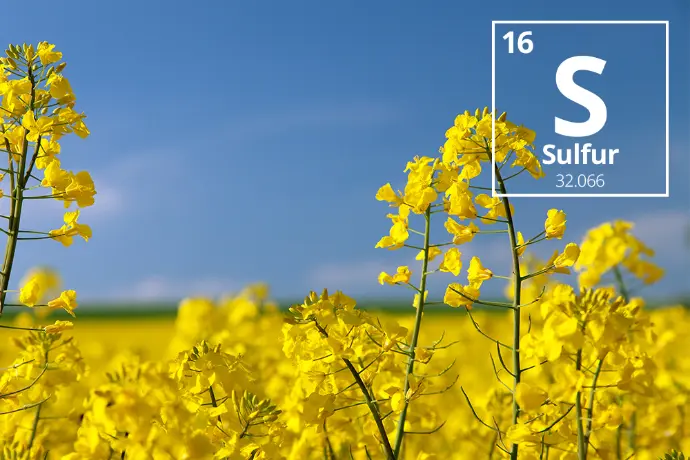Sulphur - plant growth and soil health
Sulphur is an essential natural element that enhances the efficient utilisation of the Earth's resources.
It serves as a vital nutrient for plants in agriculture, plays a significant role in sustainable urban planning, and is crucial in combating the degradation of fertile farmland.
Discover the importance of sulphur in our daily lives by delving into the resources provided below!


Sulphur
in food
production
In order for farmers to achieve profitability in their food production, the presence of sulphur is absolutely crucial to their agricultural practices.
- Serves as a natural shield against pathogens and pests due to its essential mustard oils
- Is integral to photosynthesis and the synthesis of carbohydrates
- Enhances the taste and quality of vegetables
- Plays a crucial role in the formation of amino acids, vitamins, and enzymes, particularly in bread wheat
- Helps achieve greater yields per kilogram of nitrogen applied, acting as a catalyst for nitrogen absorption
- Reduces the loss of other nutrients to the surrounding environment.
Global Sulphur consumption
114 M
Global consumption
54
Countries produce Sulphur
67 M
Sold on the global markets
SULPHUR KNOWLEDGE
Sulphur is an essential natural element that enhances the efficient utilisation of the Earth's resources. It serves as a vital nutrient for plants in agriculture, plays a significant role in sustainable urban planning, and is crucial in combating the degradation of fertile farmland. Discover the importance of sulphur in our daily lives by delving into the resources provided below!
Sulphur is found naturally in the environment and is the thirteenth most common element in the earth's crust. Although it can be extracted in its pure form, this practice has decreased significantly over the past decade, contributing to less than 2% of global output. The bulk of elemental sulphur is now produced as a by-product during oil and gas extraction processes.
Elemental sulfur is manufactured across the globe, with the most significant production taking place in areas where sour gas and oil are processed, including the United States, Canada, the former Soviet Union, and West Asia.
A substantial portion, over fifty percent, of the elemental sulfur produced is engaged in international trade. China ranks as the largest importer, trailed by Morocco and the United States. Canada leads in exports, followed by Russia and Saudi Arabia.
A significant portion of global sulphuric acid production, exceeding fifty percent, is derived from the combustion of elemental sulphur in dedicated facilities at consumption locations. The remaining supply is mainly sourced from non-ferrous metal smelters and pyrite mines. East Asia, with China at the forefront, is the largest producer of acid, driven by its rapid economic development. This is followed by North America, Africa, and Latin America.
After nitrogen, phosphorus, and potassium, sulphur stands out as a crucial nutrient for plants. It enhances crop yields in three significant ways: 1) it delivers direct nutritional benefits; 2) it acts as an indirect nutrient source through soil amendments, particularly beneficial for calcareous and saline alkali soils; and 3) it increases the efficiency of other essential nutrients, notably nitrogen and phosphorus. Sulphur is indispensable for plant growth and nutrition.
Most crops typically absorb between 15 to 30 kg of sulphur per hectare (S/ha). Oilseeds, legumes, forages, and certain vegetables often demand more sulphur than phosphorus for optimal yield and quality. The sulphur content in plants is similar to that of phosphorus, averaging around 0.25%. Standard recommendations for addressing deficiencies suggest applying 15 to 30 kg S/ha for cereal crops and silage grass, while oil crops, legumes, sugarcane, and some vegetables may require 25 to 50 kg S/ha. For more comprehensive information on sulphur needs for specific crops and regions, please consult The Sulphur Institute's publications.
Increased agricultural production has led to a greater removal of sulphur from the soil, driven by higher fertilizer application, intensified cropping practices, the adoption of high-yield crop varieties, and enhanced irrigation techniques.
Conversely, the addition of sulphur to the soil has diminished due to the rising use of high-analysis, sulphur-free fertilizers like urea, diammonium phosphate (DAP), and potassium chloride; a decline in the application of traditional organic manures and sulphur-rich fertilizers such as single superphosphate and ammonium sulphate; and a reduction in the use of sulphur-containing pesticides.
Additionally, lower emissions of sulphur dioxide have decreased the atmospheric availability of sulphur, which has historically been a significant source for agriculture near industrial regions. Stricter environmental regulations in Western Europe, North America, and increasingly in developing nations have led to a reduction in atmospheric sulphur deposition, contributing to sulphur deficiency in agricultural practices.
